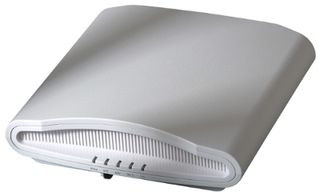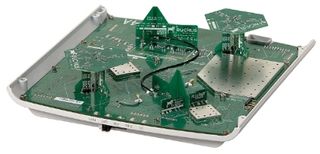Ruckus Wireless Unveils 'Industry's First' 802.11ac Wave 2 Access Point

Ruckus Wireless may cause a ruckus in the mobile access point industry with today's unveiling of the ZoneFlex R710, a device designed to extend Wi-Fi to enable multi-gigabit performance and offer unprecedented capacity for enterprise users and service providers.
The Ruckus ZoneFlex R710 is one of the first Wi-Fi access points based on Wave 2 features of the 802.11ac standard, including multi-user multiple input/multiple output (MU-MIMO) technology. MU-MIMO enables more than twice the number of mobile devices allowed than the previous generation, and it aggregates data rates exceeding two gigabits per second.
The Ruckus ZoneFlex R710 supports up to four spatial streams and up to 500 concurrent clients, and it has a built-in USB port to accommodate Bluetooth Low Energy (BLE) beacons and other Internet of Things (IoT) devices. The City of San Jose, CA, was one of the first to deploy the new tech, and they saw dramatic improvements in performance, reportedly reaching over 445 megabits per second on two–stream-devices and over 200 megabits per second with single-stream smartphones.
"We are at an inflection point in the industry as we deal with insatiable demand for wireless capacity and speed," said Vijay Sammeta, Chief Information Officer for the City of San Jose, in the press release. "We need to be able to plan and prepare for devices and services we haven't even seen yet. Wave 2 represents an investment in a platform that not only meets our current needs, it will also meet those in the future that we can't even predict."
With municipal and public Wi-Fi becoming more common, the need for high capacity and speed from our access points has never been higher, and Wave 2 802.11ac technology seems to give us a fairly high ceiling for potentially game changing innovation in the wireless segment.

Speaking of innovative features, the R710 includes the patented BeamFlex+ Adaptive Antenna Technology, which claims to deliver up to three times the performance and range, eight times the expanded coverage, maximum power efficiency, and interference mitigation. The dual-polarized antennas are capable of dynamically creating over 4,000 unique directional antenna patterns per radio, allowing the R710 to adapt to the changing physical orientation of mobile devices, improving connectivity and performance.
The Ruckus ZoneFlex R710 will be available this quarter from authorized Ruckus BiG DOG resellers with an MSRP of $1,295.
Stay on the Cutting Edge
Join the experts who read Tom's Hardware for the inside track on enthusiast PC tech news — and have for over 25 years. We'll send breaking news and in-depth reviews of CPUs, GPUs, AI, maker hardware and more straight to your inbox.
Follow us @tomshardware, on Facebook and on Google+.
-
laststop311 Shame that wireless is starting to outpace 1gbps wired connections. Intel needs to get on the ball and integrate 10gbit wired ethernet instead of 1 gbit. Wired connections should offer more speed than wireless. So the extra money for 10gbit wired ethernet needs to be spent to keep things in line with the way they should be.Reply -
zodiacfml Wired is Full Duplex, send and receive at the same time while Wi-Fi is half duplex.Reply
I have seen a review of one notebook with dual stream AC, reaching 500 mbps which is only half of 1gbps where the wired is around 85 to 90% of the speed.
10gbps requires fiber or a thick and stiff LAN cable. It's also several times more expensive than 1 gbps which is why this Ruckus AP has two 1 gbps LAN ports instead. -
zodiacfml Wired is Full Duplex, send and receive at the same time while Wi-Fi is half duplex.Reply
I have seen a review of one notebook with dual stream AC, reaching 500 mbps which is only half of 1gbps where the wired is around 85 to 90% of the speed.
10gbps requires fiber or a thick and stiff LAN cable. It's also several times more expensive than 1 gbps which is why this Ruckus AP has two 1 gbps LAN ports instead. -
photonboy 1Gbps = 125MBpsReply
A BluRay movie uses under 5MBps (24FPS) so at 60FPS the same quality requires just over 10MBps.
Where's the need for 10Gbps? That's basically 100X faster than BluRay quality at 60FPS!
Also, don't forget that wi-fi rarely performs like the specs would suggest, and LATENCY is much higher on wi-fi which is a factor for gamers.
Ethernet is still king if you can run the wires. -
WISE_guy There are actually available switches from Cisco, providing 2,5 and 5 GB/s Ethernet speeds, but they are exactly result of marketing bullshit about 802.11ac -- in real life you don't need even second 1Gb/s port on AP, as traffic is never reaching 1Gb/s limit.Reply
Ethernet is much faster and better than Wi-Fi at similar rates, as it is switched and full-duplex, and have about zero packet error rate.
If you have 100 users on 802.11ac AP, they all share same half-duplex bandwidth (which is much less than marketed "multigigabit" (866Mb/s or 1333 MB/s) in real life, and are contenting for media access. So you get average 5-10 MB/s per client if all users really use network, and even not full-duplex...
On 1GB/s Ethernet switch 100 users would have total full duplex 100x 1gb/s bandwidth without any contention, which is about 1000 times more.
So wehn you are saying that Wi-Fi is faster than Ethernet this is exactly what you compare. Doesn't look as good as just marketing pitch...
Marketing persons doesn't say this because they don't know or just don't care about facts - they are just selling.
It isn't a big problem to make 2,5Gb/s or 5 GB/s Ethernet chip any more, but you need also proper cabling, and it costs a bit more. When you need it -- you?l get it soon.
Fact is that most wired users never consume more than 100Mb/s still, so equipping everybody by 2,5GB/s adapters is just marketing, same way as it is now with 1GB/s. Most embedded "1GB/s" adpaters are cheap and unable to provide more than 200-300Mb/s speeds in fact, but it's OK, as nobody needs more, except for server applications. -
Ninjawithagun Not only is WiFi (i.e. 802.11ac) time division duplex (does not transmit and receive simulataneiously), there is a lot of overhead that reduces bandwidth compared to a hard wired ethernet connection. Packet contention, packet loss, EMI, and encryption all eat up valuable bandwidth on wireless network connections. I have both at my house, but will NOT give up my CAT7 ethernet connection from my gaming PC directly to my 802.11ac gigabit router, thank you very much :DReply -
Ninjawithagun Not only is WiFi (i.e. 802.11ac) time division duplex (does not transmit and receive simulataneiously), there is a lot of overhead that reduces bandwidth compared to a hard wired ethernet connection. Packet contention, packet loss, EMI, and encryption all eat up valuable bandwidth on wireless network connections. I have both at my house, but will NOT give up my CAT7 ethernet connection from my gaming PC directly to my 802.11ac gigabit router, thank you very much :DReply
Most Popular



